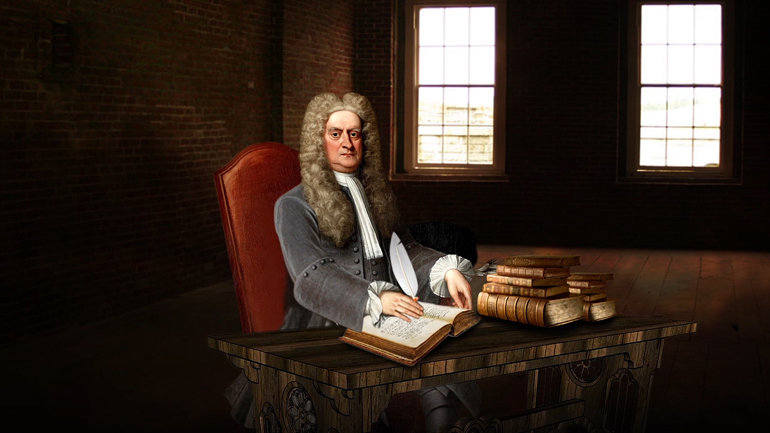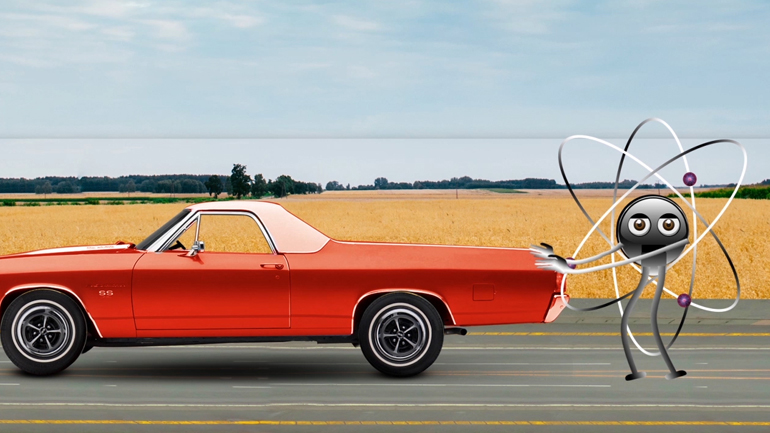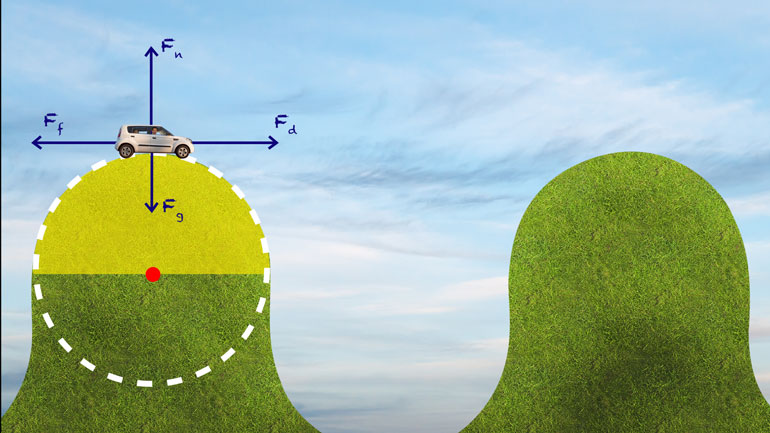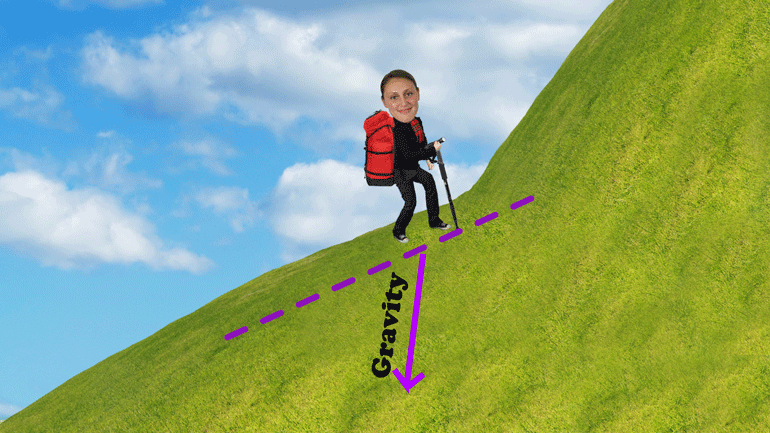ShmoopTube
Where Monty Python meets your 10th grade teacher.
Search Thousands of Shmoop Videos
Physics Videos 34 videos
Isaac Newton. Who was he? Why do we need to know about him? In a physics course, no less? Well, he's only the most famous physicist in history, and...
What are the basics of trigonometry? And why are we learning about this in a physics course? Both good questions. In this video, you'll learn about...
It's time to make our liters and meters work together. Enough of the bickering, right? In this video, we'll do some unit analysis, covering SI Unit...
Physics: Calculating the Force of Friction 10 Views
Share It!
Description:
In this video, we'll calculate the force of friction - both static and kinetic. And we'll answer that age-old question: fact or friction?
Transcript
- 00:00
Shmoop! Calculating the force, of friction. The force. The reason for that burning
- 00:08
sensation. Yeah, just moving right on from that, catching up on friction.
- 00:13
[mumbling]
- 00:22
[mumbling]
- 00:27
All right,
Full Transcript
- 00:32
here we go. Well you know sliding isn't as easy as
- 00:35
it seems. Sure it might look like a fun time,
- 00:38
kicking up dirt, as you slide into second base. But you have to make sure you know
- 00:43
when to start your slide, which means you have to think about how much friction
- 00:47
you're going to encounter, otherwise you know, things could go badly. [man on baseball field]
- 00:51
Well friction is one of those things we just know. We don't really think about it,
- 00:55
but it's such a part of our everyday life, that we have an intuitive
- 00:58
understanding of it, at least on some level. But as we've seen before, our
- 01:02
intuitive understanding doesn't necessarily match up with what's
- 01:05
happening, in terms of physics. So while you intuitively know how far you can
- 01:10
slide across the floor in your socks, without crashing into a wall like Tom
- 01:14
Cruise. Well you probably aren't thinking about the coefficient of friction, as you
- 01:18
glide along there. Well the physics definition of friction, is the force
- 01:22
that's exerted by two objects as they rub, or slide across each other.
- 01:28
Alright well friction occurs, because there's no such thing as a perfectly [man in glass store]
- 01:32
smooth surface. A piece of glass might look and feel perfectly smooth to us. But
- 01:37
if you look close enough, under a microscope, you'll see all kinds of nooks
- 01:41
and crannies on the surface. Rub your finger across a piece of sandpaper and
- 01:46
you'll feel the rough surface slowing your finger down. There's no material
- 01:50
that's perfectly smooth, at least not that we've discovered yet. But hey, if you
- 01:54
can invent a frictionless material, you'll probably become a gazillionaire [man sitting in private library with bags of money]
- 01:58
and be able to buy your own baseball team. So you know, go for it. Alright,
- 02:02
well the second factor, that determines the strength of friction, is how much
- 02:06
force is pressing the two objects together. Rub your finger down the
- 02:11
surface of your table, or you know baseball bat, if you have one lying
- 02:15
around. Just barely graze your finger across, pretty easy right? Now really mash
- 02:21
your finger down on to the table and drag it across. Well it takes a lot more [man with baseball bat]
- 02:24
effort to move your finger, when it's pressed hard against the table. Well
- 02:29
here's the mathematical formula to figure out friction. This equation says
- 02:33
that the force of friction, that F there, equals the coefficient of friction, which
- 02:39
is that mue symbol there, times the normal force, which is what the big n thingy
- 02:44
there, stands for. Well the normal force, is the force that's pressing the two
- 02:48
objects together. That's normal. The coefficient of friction is, kind of
- 02:52
like a measurement of how smooth the two object surfaces are. If the objects move
- 02:58
across each other smoothly, like two pieces of telescope reflector mirror. [man in workshop]
- 03:02
Well the coefficient will be low. If they really dig into each other, like two
- 03:07
pieces of sandpaper, or you know something rubbing the barnacles on the
- 03:11
bottom of a boat. Well the number will be really high. The coefficient of friction
- 03:15
is a value, that can only be determined experimentally. We can't just look at two
- 03:20
materials and put a number on there coefficient of friction. We have to
- 03:24
actually rub two materials across each other, to see how much friction they [scientist preforming an experiment]
- 03:28
generate. We'll get deeper into that coefficient thing in a minute. Well there
- 03:32
are two kinds of friction, static and kinetic. Static friction, is the force
- 03:37
between two objects, when they're in contact. But not moving. When they're
- 03:41
touching, you know just sitting there. Kind of like a congressman. Kinetic
- 03:45
friction, is the force of friction, between two objects that are sliding
- 03:49
across each other. Kinetic friction is almost always weaker
- 03:52
than static friction and you've probably had experience with that, if you've ever
- 03:56
pushed a car, you know it takes more effort to get it moving, than it does to [two men pushing car]
- 04:01
keep it moving. Of course it takes even less effort to remember to fill up the
- 04:05
gas tank in the first place, but that's topic for neurology, not physics and good
- 04:10
luck with that. Why is static friction stronger than
- 04:13
kinetic friction? Well when two objects are stationary, those nooks and cranny's
- 04:18
we talked about earlier, have a chance to really get in close with each other.
- 04:22
They're kind of hooked together, but when they're sliding, they don't
- 04:26
have the chance to cozy up so much, or so deeply. So it's easier to keep things [car rolling on pavement]
- 04:32
just kind of bump and moving along there. Let's get back that coefficient of
- 04:35
friction thing. Well like we said before, the only way to find the coefficient is
- 04:39
to actually rub the two things together. Luckily for us, some smart scientists
- 04:43
have been rubbing stuff together for a long time. Which might sound
- 04:47
inappropriate, but it's not. This is a g-rated video people. They've already
- 04:51
discovered the coefficients of friction for a bunch of materials and you can
- 04:55
find some of them right here. Alright well the coefficient of friction, is a [list of coefficients]
- 04:58
ratio of the force of friction, between two objects and the normal force pushing
- 05:05
them together. In most cases it's a number, between 1 and 0, because in most
- 05:09
cases, the force of friction is less than the normal force.
- 05:13
Now think about when you pressed your finger hard against the table and then
- 05:17
slid your finger across it. The force you used to slide your finger, was less than [man rubbing his finger on bat]
- 05:23
the force you were using to press down. Well there are some materials that have
- 05:27
a coefficient that's higher than one. Like certain kinds of rubber, for example.
- 05:31
Like the rubber hooks on to the other piece of rubber and the hooking this
- 05:35
creates incredible friction and it's like very hard to slide it, got it?
- 05:39
The coefficient can depend on a lot of factors though. The coefficient of
- 05:42
static friction, is almost always higher than the coefficient of kinetic friction.
- 05:47
Is the surface wet, or dry. Well ice is slippery enough, when it's below freezing
- 05:52
outside. But what happens when that ice starts to melt? Well that's a recipe for [woman slipped on icey sidewalk]
- 05:57
a broken tailbone. And when you're trying to stretch that single, into a double, it
- 06:02
can seem like the coefficient of friction between you and the infield
- 06:06
dirt is like somewhere around 60. So let's have some fun with friction.
- 06:10
Let's say I struck out, just pretending here and I'm dragging my bat onlong the
- 06:16
ground, as I head to the dugout. Hanging my head in shame. The bat has a
- 06:20
mass of, 0.88 kilograms and takes 6.7 Newton's of force, to get it
- 06:24
moving along the grass and 4.2 Newtons to keep it in motion at a constant [man dragging bat]
- 06:29
velocity. Well, what are the two coefficients of friction, between the bat
- 06:33
and the baseball field? Well, okay the force needed to get that bat moving is
- 06:38
going to relate to static friction. After what was happening to the bat before we
- 06:42
started dragging it. Well nothing, nothing at all. Nothing was moving it and anytime
- 06:47
we have an object at rest, we know we have a first law situation. Where the [baseball player talking]
- 06:51
forces are balanced. Newton's first law states that, objects at rest, tend to stay
- 06:57
at rest, objects in motion, tend to stay at motion. Well the only way motion
- 07:01
changes, is if a force is applied to it that is out of balance with any other
- 07:06
forces affecting it. Something that's just resting on the grass isn't
- 07:10
experiencing any imbalance of force. And the force to keep it moving is going to
- 07:15
relate to kinetic friction. Since we have constant velocity when the bat is moving,
- 07:20
we know we have balanced forces, here to. Remember when there's no acceleration,
- 07:25
either positive, or negative. Then we have another case of balanced forces. So let's [equations on chalkboard]
- 07:31
figure out the kinetic coefficient first. Alright, our formula tells us that
- 07:36
friction equals the coefficient, times the normal force. We're trying to find
- 07:40
that, mue thingy, right there. We'll go ahead and make a Freebody diagram for
- 07:45
this. There we go and the square here is our bat and we've got our forces all
- 07:50
lined up. Alright, we know our applied force and we know how to find the
- 07:54
gravitational force. We don't know the force of friction, F sub F and we don't [diagram and equations]
- 07:59
know the normal force, F sub n. So let's rewrite our friction formula, in terms of
- 08:04
our FB D, so we don't get confused. Well F sub F, equals the coefficient, times F sub
- 08:10
n. We know our applied force is 4.2 Newton's. Well since our forces are all
- 08:15
nice and balanced. The force of friction has the same magnitude. Well how about
- 08:19
the normal force? Well it's gonna match the force of gravity and we know how to
- 08:24
find that out. The force of gravity equals, mass times the acceleration of [formulas on chalkboard]
- 08:28
gravity. Well the mass is 0.88 kilograms and gravity is as reliable as it gets
- 08:33
with an acceleration of 9.8 meters per second squared. So the bad has a weight
- 08:39
of 8.6 Newtons and the magnitude of the normal force is exactly the same. Now
- 08:45
that we have the numbers, we can find the coefficient. Well 4.2 Newton's equals, the
- 08:50
coefficient of friction, times 8.6 Newtons.
- 08:53
To isolate coefficient, we divide each side by 8.6 newtons and that tells us
- 08:58
that the coefficient of kinetic friction equals 0.49. [equations on chalkboard]
- 09:02
That'll be mue sub K, so we don't get it all mixed up with static friction. Well
- 09:07
to solve for that static coefficient, we just have to swap in the right force. Our
- 09:11
equations already set up for us, it took 6.7 newtons to get the bat moving. We
- 09:16
divide both sides of the equation by 8.6 Newton's. Giving us a static coefficient
- 09:21
of 0.7 8 and that looks about right. The static coefficient should be higher, than
- 09:26
the kinetic coefficient, in most cases. Right? But I'm mad about striking out. I
- 09:31
want to get a hit and I'm so mad, I'll hit pretty much anything. Like say the[baseball player in locker room]
- 09:37
shelf that the watercooler is sitting on. Great so now I've done it, I've broke
- 09:42
the shelf on one side, creating an incline. The watercooler has a mass of
- 09:46
6.6 kilograms and the incline has an angle of 38 degrees. Well if the water
- 09:50
cooler and the shelf have a coefficient of friction of 0.48. How fast will the[watercooler on its side with equations]
- 09:56
water cooler accelerate? Okay, let's figure this thing out, before the manager
- 10:00
comes here to yell at me. Here's a force diagram of this mess. Which looks pretty
- 10:06
familiar, to what stuff we've worked on in previous lessons, right? To make things
- 10:11
easier on ourselves, let's tilt the diagram, so the incline is on the x-axis.
- 10:15
There that's better. Only one diagonal line to deal with. We'll go ahead and add
- 10:19
in the component vectors for gravity in the X and y directions. Before we go
- 10:24
too far, let's set up our second law equations. Well Newton's second law tells
- 10:28
us, that the sum of all forces along one plane, equals the sum of forces in the [formulas on chalkboard]
- 10:34
positive direction, minus the sum of forces in the negative direction. The sum
- 10:39
of forces on the y axis, equals F sub n, minus F sub G Y and the sum of forces
- 10:46
along the x axis, equals F sub G X, minus F sub F. So let's tackle the Y forces
- 10:52
first. Step one is to put F sub y in terms of F sub G and F sub G, equals mass
- 10:58
times the acceleration of gravity. Well we'll do the math on that one real quick.[equations on chalkboard]
- 11:03
6.6 kilograms, times 9.8 meters per sec
- 11:07
second square, gives us a force of 65 Newtons. Our angle here, at the top of our
- 11:12
component triangle, will match the theta angle, of our incline and we'll need that
- 11:17
to figure out F sub G y. Trigonometry is gonna be our weapon of choice here.
- 11:21
Cosign theta, equals f sub G y, over f sub G. Pop in the numbers and multiply both
- 11:27
sides by F sub G, to solve for F sub G Y. Well F sub G y, equals 51 Newtons. Which [formulas on chalkboard]
- 11:34
means the normal force F sub n, has the same magnitude. Alright, now for
- 11:40
friction. What's our friction formula? Well friction equals the coefficient,
- 11:43
times the normal force. Our coefficient is 0.48 and our normal force is 50 1.2
- 11:50
Newton's. Meaning friction has a force of 25 Newtons, in this case anyway. Write
- 11:55
that down somewhere, we'll need it soon. But first we need to figure out the X [person writing on paper]
- 11:59
component of gravity. We'll use the sign function for that one.
- 12:02
Well sign theta equals, F sub G x, over F sub G. The solving for F sub G X, gives us
- 12:08
a force of 40 Newtons. Yeah, see what we did there. Now we can find the sum of forces,
- 12:13
on the X plane. Well the sum of forces in the X Direction, equals F sub G X, minus F
- 12:18
sub F. Well F sub G X, is 40 Newtons and F sub F is 25 Newtons, giving us a net
- 12:25
force of 15 Newton's. Fantastic, now we have what we need to find the [man in locker room with broken water cooler]
- 12:29
acceleration of this water cooler. Then we can see how fast I'm accelerated back
- 12:35
down to the minors. Well force equals mass, times acceleration. Our force is 15
- 12:40
Newtons and our mass is 6.6 kilograms, we divide each side by the mass to solve
- 12:45
for acceleration. Meaning that cooler is accelerating at 2.3 meters per second
- 12:50
squared. No friction is one of those things that seems simple, until we really [baseball game]
- 12:54
start thinking about it. We've been running into a lot of these things in
- 12:57
physics, but it's always good to get a deeper understanding of how stuff
- 13:00
actually works. Well for one thing, now we know that there are ways to reduce
- 13:04
friction. Like motor oil, which reduces friction in a car's engine. Yeah, if
- 13:09
I want to steal second base, I can just pour motor oil all over myself and [baseball player running]
- 13:14
reduce that coefficient of friction. What could go wrong? Is that legal?
Related Videos
When you're about to marry the love of your life, not many things could stop you. However, finding out that your future hubby is keeping his crazy...
Here at Shmoop, we work for kids, not just the bottom line. Founded by David Siminoff and his wife Ellen Siminoff, Shmoop was originally conceived...
ACT Math: Elementary Algebra Drill 4, Problem 5. What is the solution to the problem shown?
AP® English Literature and Composition Passage Drill 1, Problem 1. Which literary device is used in lines 31 to 37?
AP® English Literature and Composition Passage Drill 2, Problem 1. What claim does Bacon make that contradicts the maxim "Whatsoever is delig...






































